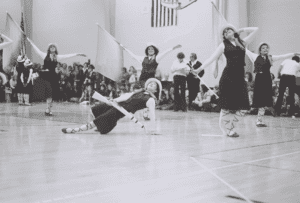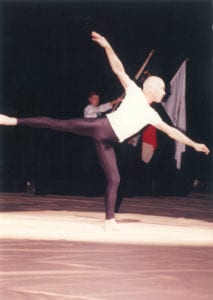This is Part II of a three-part series. To read Part I, click here.
By Jenny Lyons
Beyond his generosity within the drum corps activity, Stanley became integral in the creation of Winter Guard International. Not only was he among the six original founders—including Don Angelica, Shirlee Whitcomb, Bryan Johnston, Marie Czapinski and Linda Chambers—Stanley “led the charge” says fellow co-founder Marie Czapinski. Stanley procured the funding and sponsorship that would eventually spearhead the passion project, turned international organization, WGI.
“We all wouldn’t be here without him,” Marie states. “He was a true visionary.”
Beyond belief; breaking expectation.

In winter of 1979, one year after WGI’s flagship season, Stanley once again had a hand in shifting tradition. In a world of stiff leather boots, “high mark-times,” and an iron-clad focus on hands and equipment, Stanley swept in with the Seattle Imperials: clad in soft ballet slippers, theatrical makeup and costumes, a softer style, and a visual appeal far ahead of its time. In performing the first ever color guard show grounded completely and consistently in dance technique, the Imperials opened the door to modern era and, in doing so, paved the way for so many of the innovative moments that would come after them. As a judge, Marie remembers the integration of dance with equipment entirely shifting her perspective.
“It totally opened my eyes as a judge and elevated my awareness as to what was possible,” she says.
Beyond breaking expectation, Stanley was careful to thoroughly elevate the activity further by educating his fellow instructors, designers and judges. He insisted that his peers open their eyes to the world of movement and its principles by bringing in dance experts from the Laban Institute in New York to introduce the concept of kinetic space and its relationship to the activity.
Marie asserts, “It changed the course of color guard, forever.”
A fluid stance of education and art.
Stanley was committed to education and changed the landscape of his own vision through the study of dance. He pursued his BA in Dance at Cornish College of the Arts during his time in Seattle, and remained a lifelong student of dance. His studies informed his stylistic choices, his teaching philosophies, and—ultimately—his legacy as a bold visionary within the activity. He pushed boundaries with his educational tools at WGI conventions and events; he implemented improvisation, weight sharing and creative freedom.

Carol Abohatab, whose celebrated career has included dance-focused work with both the Bluecoats and Santa Clara Vanguard’s Winter and Drum Corps’ programs, as well as influential work with WGI’s steering committee, recalls one such improvisation session.
“These are all accepted as normal now,” Carol says. “My feet had barely made contact with the floor. We were all sweating and, well…exhilarated. It was the Stanley touch.”
As is the way of change, Stanley’s contributions did not come without criticism. At first, many judges and audience members failed to understand or enjoy what they were seeing. Being ahead of his time, Stanley often faced criticism from older judges who preferred the militaristic roots of the activity. Nevertheless, the Seattle Imperials persevered until the judging system evolved to reward dance and movement. Until then, Stanley stood by his art. He saw that dance unfettered the activity, effectively removing the boundaries of what would ultimately be possible to express through color guard.
“Stanley clawed and scratched and made himself heard until he effected change,” Marie recalls.
Carol reiterates, “In those days, it was common for people to really debate issues and premises—in fact, the wording and tempers could get quite heated—and Stanley was a big part of the passionate discussions,” she says. “Fighting for the integrity of movement, always.”
Farther up the ladder.
Eventually, scoring and design recognized Stanley Knaub’s work for what those close to him already knew. Marie describes the way in which Stanley elevated the level of performance possible within the activity:
“The performers were so committed to it and so beautiful. They drew you in and made you believe.”
Such is the quality of performance that keeps WGI alive and flourishing. Color guard designers and performers continue to push the depths from which their emotions are mined and the heights to which their expression can be shared.
 About the Author: Jenny Lyons is a freelance writer and master’s student of writing at San Francisco State University. She has a BA in Literary Journalism from the University of California, Irvine. She is an alumna of WGI, having performed with the Santa Clara Vanguard Winter Guard from 2013 to 2015, during which time she was fortunate enough to become a WGI World Champion. Jenny has also marched with several drum corps including the Santa Clara Vanguard. When she is not writing, Jenny can be found continuing her passion for color guard through teaching in the Bay Area and serving as caption head to the Vanguard Cadets.
About the Author: Jenny Lyons is a freelance writer and master’s student of writing at San Francisco State University. She has a BA in Literary Journalism from the University of California, Irvine. She is an alumna of WGI, having performed with the Santa Clara Vanguard Winter Guard from 2013 to 2015, during which time she was fortunate enough to become a WGI World Champion. Jenny has also marched with several drum corps including the Santa Clara Vanguard. When she is not writing, Jenny can be found continuing her passion for color guard through teaching in the Bay Area and serving as caption head to the Vanguard Cadets.
































